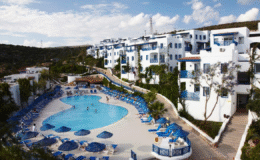

I’ve been working around sea ice for close to two decades on and off – and have had the privilege of being up close and personal with floating chunks of frozen ocean in both the Arctic and Antarctic. An enduring geophysical question about sea ice is “how much ice floats on the ocean?”
Sea ice, made from frozen sea water, is a dynamic complex composite made from ice, snow and brine in different forms and layers. It drifts on the ocean, becomes thicker by more freezing (thermodynamic) and also being piled up on top of itself (dynamic). It cracks and breaks up. It forms chunks (ice floes) at scales from many kilometres to just a few centimetres; and most often the very large ice floes are made from many smaller ones.
A key point to take from all that is that sea ice varies on scales from kilometres to metres. From satellites we can get an idea about what’s happening at kilometre-scales. However, it is not easy to discover whether estimates about sea ice properties at those scales are correct. We need to be able to understand what is integrated into a measurement at that scale.
This was the subject of my previous work as a researcher – working toward understanding what happens at metres to tens-of-metres scales; and using that to help validate larger scale estimates. A key part of that question is then understanding how much ice is level and relatively uniform in thickness, and how much is formed into ridges and other deformed (usually thicker) regions. Also, how are level and deformed regions related to each other? And importantly, where are we sampling generally in relation to different ice types?
If we know something about the geography of our sampling sites, we can start to ask more complex and intuitive questions – for example why does some biology thrive here and not there? What can we add to improve earth system model performance? How can we update policies around sea ice impacts on structures in the ocean?
This story sketches out an approach exploring sea ice as a landscape analysis problem – applying a geomorphon analysis to high resolution topography. If it all works, can this approach help with understanding the physical geography of sea ice?
The pack ice zone is unimaginably vast. In Antarctica, 19+ million square kilometers at maximum extent (two and a third Australias!). Shouldn’t we measure things at larger scales?
Yes, and also no. We absolutely lack knowledge of how larger scale observations are assembled – what’s in a pixel. This is why there was a massive investment in the work I’ve been privileged to be a part of. Sea ice is a complex multi scale composite that varies at scales from centimetres (fine sastrugi, radar-important snow layers, brine channels) to many kilometres (vast ice floe aggregates, averaged concentration). To use a medical analogy, we currently understand it at the level where we know that organs and cells exist, we don’t know how they’re really put together or connected – or what’s inside them. We’re modelling how it impacts earth systems without really knowing how it works.
Walking across an ice floe, you might find that it is truly flat for a couple hundred metres. Or you might find yourself climbing over 2+ m high ridges. It might be snowy, it might be bare ice. It might be 10 cm of snow or it might be 1.8 m of snow. It might be 15cm or 1.5 metres thick. Or you might walk from 15 cm to 3 m thickness in one step. It also changes a lot – every time we walk onto sea ice we observe a place no human has seen, or will ever see again! I wrote more words about that here.
Without understanding more detail, and how that detail is connected, we are a bit blind. And observations over wide areas at smaller scales are essential glue. The NASA icebridge program did a lot of work on this – as do AWI’s programs in the Arctic. It remains extremely difficult to get on the ground for calibration / validation and smaller scale work to ensure that even close range remote sensing is observing what we think it is.
Geomorphons are classes of topographic forms (3D shapes in the landscape) determined using a neighbourhood approach – for each cell in a digital elevation model (DEM), doing some analysis of what nearby cells look like in order to decide what class of form the target cell belongs to. The method is described here: https://doi.org/10.1016/j.geomorph.2012.11.005.
The process is strongly related to previous efforts on classifying sea ice using methods drawn from computer vision – morphological operations, using texture as a parameter in determining ice types (see the methods section in this work: http://dx.doi.org/10.1029/2007JC004181) , then superpixel segmentation and labelling (http://dx.doi.org/10.1029/2011JC006961). So it is a natural fit to expand a computer vision approach into three dimension.
Identifying ridges in sea ice from 3D data is so far primarily done using elevation thresholding (see for example https://doi.org/10.5194/tc-10-1161-2016) – which works, however means that we may include snow dunes in the analysis; or also miss the ability to do rapid mapping and analyse data which is imperfect-but-useful. A classic case is drone mapping – where an elevation map may be tilted or warped in some way.
A long while ago I tried a method using neighbourhood variance – identifying deformed ice using the standard deviation of neighbourhoods in an elevation model. The primary issue with this approach is that it was a single-scale effort. If there are ridges larger or smaller than a chosen scale, they get lost. In addition, surface variation in non-ridged areas (dunes, sastrugi) was often enough to create a false positive. You can see the effort in chapter 5 of my doctoral dissertation: https://doi.org/10.25959/23240135.v1
Geomorphons offer a similar approach – using neighbourhood analysis to determine feature shapes. What the idea does really well is use more complex descriptors of variation (how is that variability distributed within the neighbourhood?), and adds a variable size scale to what might count as a feature or form. I wish I’d read the paper in 2012 – however we all get silo’ed, especially in polar science, and forget that the rest of geomatics is solving the same problems on different media. Also in 2012 I probably would have had to write the analytical algorithms myself (just like the first efforts at texture based sea ice image analysis)!
So it is better late than never. And wonderful that the open geospatial community has implemented this method faster and better and more robustly than a field glaciologist could have!
This approach for landscape classification is a natural fit for high resolution topographic studies of sea ice, working toward an integrated geography – how are things connected, why are they where they are? We don’t know if we can say things about the relative peakiness or shape or deformity or relationships between them and how suitable or not the sea ice is as a platform for life, or whether any of that contributes to sea ice growth and melt, and then the contribution of sea ice to the vast physical system of oceans and then climate as a whole. Small landscapes, big questions. Having a tool to say more about the shapes and scales of sea ice is really important.
I’ve used QGIS to apply the GRASS GIS implementation (r.geomorphon – https://grass.osgeo.org/grass-stable/manuals/r.geomorphon.html) on elevation models of sea ice derived from drone surveys ( https://doi.org/10.1002/gdj3.70001 ) and lidar ( https://doi.org/10.4225/15/57749CB4652C4 ).
As for texture based image analysis, the scale of the forms is important. Geomorphon parameters may change based on the area and season of operations – and the scale at which data are collected. Using the r.geomorphon method in QGIS the parameters are:
Here’s an example from the Arctic – using a sea ice worksite modelled from drone imagery. It is ice station 6 (NLEG P6) from the Nansen Legacy Project research voyage in March 2021 (See: https://doi.org/10.7557/nlrs.6689 ) , approximately 81.5 degrees north, 30 degrees east. This example uses an outer search window of 10 m, an inner window of 1 m, a slope limit of 1.35 degrees and a flatness distance of 10 m. The source DEM resolution is 0.05 m (5 cm)

It looks pretty good here – we’re capturing obvious ridges, and mostly leaving flat parts out.
Heading south, here is an example from SIPEX-2 ice station 6 (2012, approximately 65 degrees south,120 east) using both lidar and photogrammetry elevation models. In this example the photogrammetric DEM has a resolution of 0.2 m (20 cm), and the lidar DEM is derived with 2 m pixels. Geomorphon parameters were 50 m outer search distance, 5 m inner search, 1.5 degrees slope threshold, 12 m flatness distance.

It shows that ridge features are classified using a geomorphon approach in both types of datasets – and so are snow dunes! This happens at both lidar (around 1m point spacing / realistically 2 m DEM resolution, orange / yellow features identified above) and photogrammetry (0.1 m point spacing, realistically 0.2 m DEM resolution – red/purple/black features) scale. It will need more work to successfully identify snow dunes as distinct features, beyond the scope of this article.
Using geomorphons or related geomorphometric tools on sea ice requires a snapshot of data at an appropriate resolution. At 30m, bumping up to approximate Sentinel-1-ish altimetry resolution, we get something like this:

I hope it is clear here that the regions we could class as “deformed ice” are roughly similar – which is great! What I hope is also clear is that we lose a lot of detail. The photogrammetric DTM geomorphon patch is about the scale of a region usually occupied by field calibration / validation observations and measurements – which is kind of loosely characterised at 30 m resolution, however it would be very hard to tell a compelling story about relationships between ice ridging and ecological communities using such a broad brush. Especially if we know how to do better!
Looking at how these types of analyses might contribute to broader climate models, a very quick number check reveals that at 2 m per pixel we’d count 43% of this area as deformed ice. At 30 m per pixel, that changes to 70%. Which quite a change! Especially if we then feed those numbers to a sea ice model which propagates them across 19 million square kilometres. I need to very carefully emphasise that these numbers are for demonstration purposes only, I’d expect to take a lot more care in the analysis if I were to publish these as any form of truth. The key takeway is that resolution matters.
(note – I will probably add a 5 metre resolution example also, approximating products from higher resolution radar instruments)
As a last word about satellite data is vitally important to recognise that sea ice elevation models from ICESat, ICESat 2 and CryoSAT-2 are both temporally and spatially integrated. Because drifting pack ice is always moving, this results in a single pixel effectively being a ‘smear over time’. A single pixel might also contain aggregates of multiple laser shots within the pixel footprint – so we can’t really know what topography at an ice floe or smaller scale looks like.
All the data used in this exercise are rasters (images, made of square cells) created from point clouds – which contain richer 3D data and relationships, often at finer scale. For example the lidar elevation models used above are made of cells measuring 2 m along each side. The lidar data themselves are spaced at just over 1 m apart. The raster elevation model needs more than one point per cell to have – in a way – statistical strength. Some reassurance that a single point in a cell is not a random outlier.
So why is this about using raster data (images made from true 3D datasets) instead of the raw data themselves? Because it is likely a more convenient and transferrable approach. It is potentially more likely that a landscape analyst is thinking in terms of rasterised DEMs rather than native point cloud neighbourhood relationships. I’ve explored PDAL‘s covariancefeature tools for this exact purpose – and others, including removal of installed infrastructure from terrestrial laser scanner data on sea ice. It is a story I’d like to write out at some point – an example is given in the image below.

Without funding, nothing.
I’ve written this out because it is an itch I needed to scratch. It would be great to keep it going and develop / improve / resolve into a real analytical solution for sea ice morphology, especially with new large icebreaker capacity available in Australia. And also now with vastly greater experience/insight into how to work with the data already to hand.
So what’s next? As it stands, not that much. If you’re funded and this idea is new to you and lights your fire, I’d appreciate acknowledgement. Even better, I’d love to hear from potential collaborators in funding – to continue an important and missing component of sea ice research!
I am also very happy to hear about opportunities to work on other landscape analysis applications – especially for cryosphere (the frozen parts of Earth) and mountain related systems.
Spatialised is a fully independent consulting business. Everything you see here is open for you to use and reuse, without ads. WordPress sets a few cookies for statistics aggregation, we use those to see how many visitors we got and how popular things are.
If you find the content here useful to your business or research you can support production of ideas and open source geo-recipes using the links below. Or hire me to do stuff; or hire me to talk about stuff.
Stripe |
LiberaPay |
 1
Mardin kenti ve kuruluş yeri
17 kez okundu
1
Mardin kenti ve kuruluş yeri
17 kez okundu
 2
Uluslararası Öğrenci Deneme Yarışması Ödülleri Sahiplerine Ulaştı –
17 kez okundu
2
Uluslararası Öğrenci Deneme Yarışması Ödülleri Sahiplerine Ulaştı –
17 kez okundu
 3
Bodrum’da yaz sezonu ateş pahası: 2025 beach fiyatları cep yakıyor
15 kez okundu
3
Bodrum’da yaz sezonu ateş pahası: 2025 beach fiyatları cep yakıyor
15 kez okundu
 4
İnsanlar yemek için ekstra mil gidiyor
15 kez okundu
4
İnsanlar yemek için ekstra mil gidiyor
15 kez okundu
 5
Yeni bir kamera kullanarak – düşüncelerinizi hazırlamak.
13 kez okundu
5
Yeni bir kamera kullanarak – düşüncelerinizi hazırlamak.
13 kez okundu